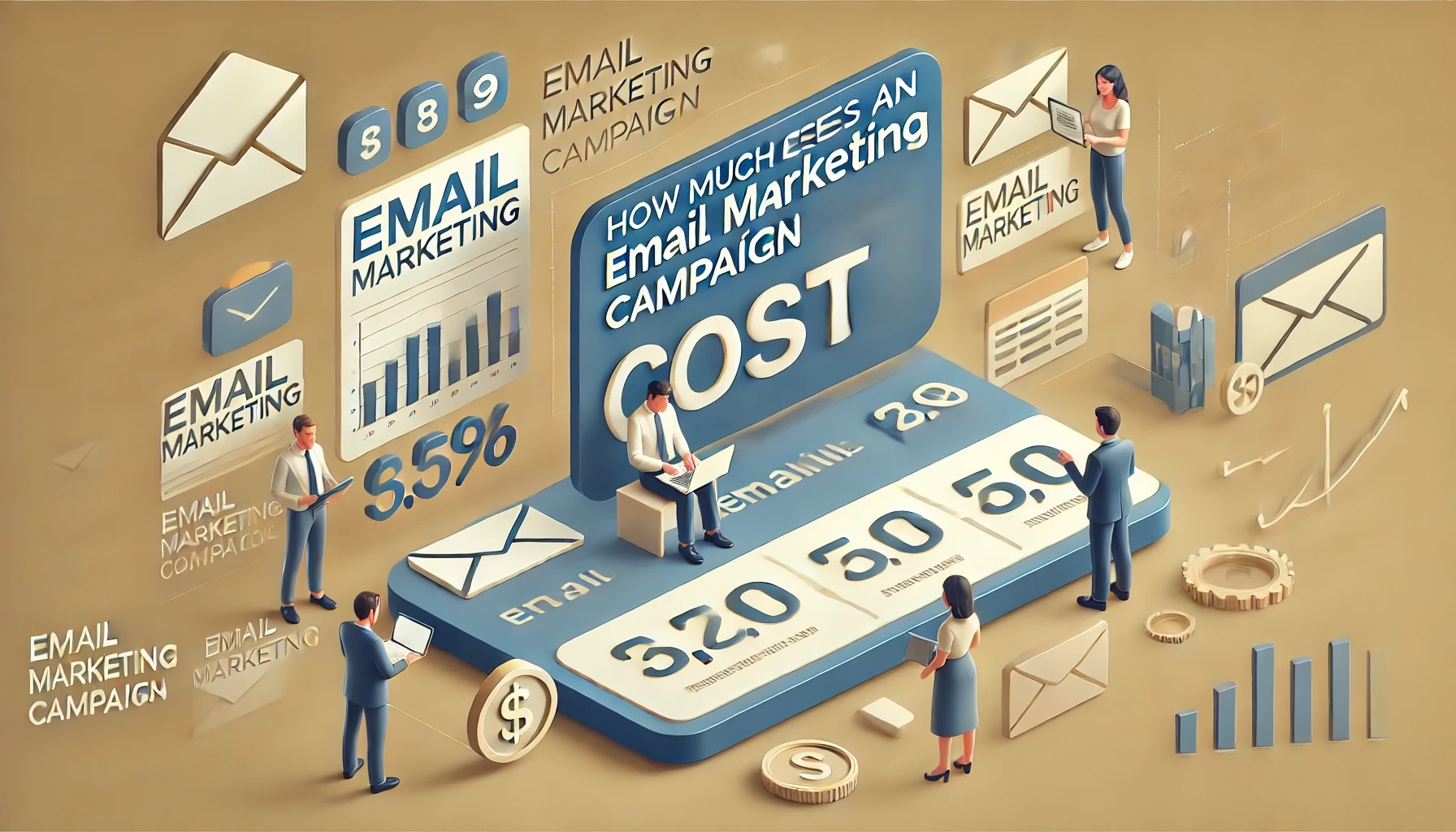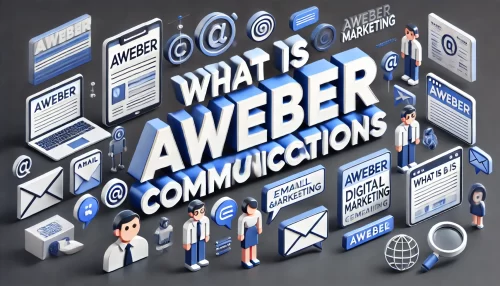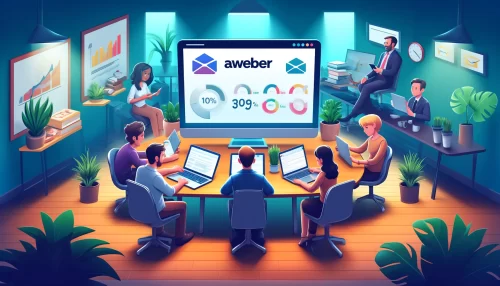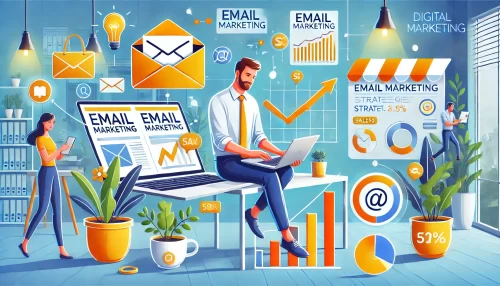Table of Contents
How much does an email marketing campaign cost? Are you curious about the expenses involved in launching an effective email marketing campaign?
Understanding the various cost components is essential for budgeting and maximizing return on investment. This guide delves into the factors influencing email marketing costs, helping you make informed decisions.
Key Factors Influencing Email Marketing Costs
A range of factors influences the cost of an email marketing campaign. These elements impact both upfront expenses and ongoing investments, from software and design to list management and automation. Understanding these components helps in planning an effective budget.
Email Marketing Software Expenses
Email marketing software is the backbone of any campaign, enabling list management, segmentation, and automation. Costs vary depending on the platform and features, from basic email-sending capabilities to advanced tools with CRM integration and AI-driven analytics.
Some platforms charge based on the number of contacts or emails sent, impacting total costs. I recommend starting with a plan that matches your list size and scaling as your needs grow. Many tools offer a free trial, so it’s worth testing a few options first.
More comprehensive software options, like HubSpot or Salesforce, come at a higher price but provide deeper integration with other tools. For businesses seeking robust data and segmentation features, these can be valuable investments.
Consider software scalability, as growing lists may increase software expenses significantly. Choose a platform that aligns with your current and future marketing requirements to avoid unexpected costs.
Content Creation and Design Fees
Content creation and design are crucial for engaging emails that resonate with your audience. Design costs can vary widely based on the level of customization and whether you hire a designer or use templates.
Creating personalized, relevant content takes time, especially if the goal is to provide value rather than just promote products. Hiring a writer or designer can ensure your emails look professional and align with your brand’s tone.
Design quality directly impacts engagement; emails with high-quality visuals and well-crafted messages drive more conversions. I advise budgeting for professional design services, especially for campaigns with high stakes.
Many businesses use pre-designed templates, which can reduce costs. Templates work well for regular updates but may lack the unique branding needed for larger campaigns or new product launches.
List Management and Segmentation Costs
Effective list management helps ensure emails reach the right audience. Many email platforms charge based on contact numbers, so organizing and segmenting lists can help optimize costs.
Segmented lists lead to more relevant campaigns, which often result in higher engagement. Some tools offer built-in segmentation, while others may require manual work or additional fees.
List hygiene, such as removing inactive contacts, is essential to control costs and maintain deliverability. Regular list cleaning can improve open rates and save on per-contact fees.
For businesses with multiple audience segments, dynamic segmentation options are ideal. These enable tailored messages to different groups without incurring extra list fees or maintenance tasks.
Automation and Personalization Investments
Automation tools streamline campaign management, saving time and ensuring timely delivery of targeted emails. These tools can carry additional costs but offer substantial ROI by driving engagement with relevant content.
Personalization can increase open rates and conversions, as audiences respond better to tailored messages. I suggest using automation to simplify repetitive tasks and maintain consistent messaging across all campaigns.
Investing in advanced automation, such as drip campaigns or triggered responses, can enhance user experience. Although setup can be time-intensive, the long-term benefits in engagement and conversions often justify the cost.
Customizing email flows for different customer journeys can further boost relevance. This approach often results in higher retention rates and stronger brand loyalty.
Analytics and Reporting Expenditures
Analytics tools provide insights into campaign performance, helping you refine strategies over time. Some email platforms offer basic metrics, but advanced analytics may require additional investments.
Detailed analytics help identify what works, from subject lines to content types. I recommend using analytics to track metrics like open and click-through rates to understand campaign success.
Platforms like Google Analytics can provide more in-depth data, especially when integrated with your email software. This added layer of analysis can improve future campaigns and help identify high-performing content.
Data-driven insights allow for smarter decision-making. By regularly analyzing campaign results, you can optimize budget allocation and focus on strategies that maximize ROI.
Comparing In-House Versus Outsourced Email Marketing
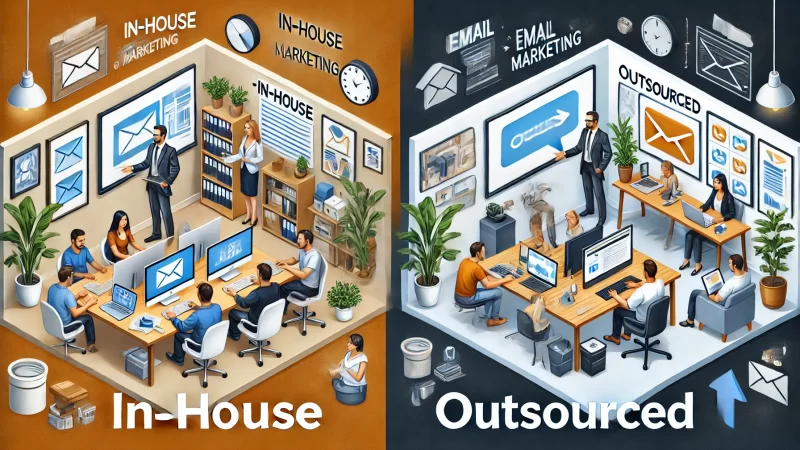
Choosing between in-house and outsourced email marketing impacts costs significantly. Each option has unique expenses, advantages, and limitations. Examining your business needs and budget can help you determine the best approach for your campaigns.
In-House Email Marketing Team Expenses
Hiring an in-house team involves fixed costs, such as salaries, benefits, and software. This option provides control over content and strategy, ideal for brands wanting a hands-on approach to email marketing.
Building a skilled in-house team can initially be resource-intensive. I advise considering the long-term benefits of having team members who understand your brand’s voice and objectives.
Ongoing training for team members ensures they stay updated on trends, benefiting your campaigns. Investing in training can enhance results, though it’s a budget consideration.
Many businesses start with an in-house team for tighter control over messaging. It allows brands to develop unique, personalized campaigns without third-party dependencies.
Costs of Hiring an Email Marketing Agency
Hiring an agency for email marketing can reduce workload and provide expertise, though often at a higher price than an in-house team. Agencies bring industry knowledge and resources that can enhance campaign performance.
An agency offers access to a team of specialists, often producing high-quality content and designs. I suggest considering an agency if your business lacks internal expertise or has multiple campaigns requiring professional handling.
Agency pricing structures vary, with options for retainer fees, project-based rates, or performance-based models. Each option offers flexibility depending on campaign frequency and budget.
While agencies provide convenience and expertise, be clear on contract terms. Having clarity helps manage expectations and avoid unexpected charges for additional services.
Freelancers and Consultants: Budget-Friendly Options
Freelancers and consultants can be cost-effective alternatives, particularly for smaller businesses or occasional campaigns. They bring specialized skills without the long-term commitment or cost of an agency.
Freelancers offer flexibility, allowing you to scale up or down based on needs. I recommend this approach for businesses needing occasional content or design assistance rather than full-time support.
Consultants bring expertise to specific campaign aspects, like list management or strategy. Engaging a consultant for one-off projects can provide value without overextending your budget.
Hiring freelancers or consultants requires a clear scope of work. This approach ensures that you’re getting the needed expertise within your budget, maximizing campaign value.
Pricing Models for Email Marketing Services
Understanding email marketing pricing models is essential to budget planning. Each model has unique advantages, offering flexibility based on business needs, campaign frequency, and resource availability. Choosing the right model aligns your investment with campaign goals and expectations.
Pay-Per-Email Sent Pricing Structure
The pay-per-email model charges based on the number of emails sent, making it suitable for businesses with predictable email volumes. This model allows cost control since you only pay for each email, avoiding fixed fees.
Many small businesses prefer this option for flexibility, particularly when scaling campaigns. I recommend pay-per-email for brands starting with a limited audience, as it allows gradual budget growth alongside subscriber lists.
As campaigns grow, costs may increase, which is something to consider when expanding email lists. Larger companies with consistent sending needs might find this model costly if email frequency is high.
This model offers clarity, as each email sent contributes directly to the total expense. You’ll find it easier to calculate costs per campaign, making it a transparent option for budget-conscious marketers.
Monthly Retainer Fee Arrangements
With a monthly retainer, businesses pay a set fee for ongoing services, ideal for regular campaigns. Retainer fees ensure predictable costs, making it easier to budget, especially for companies with consistent monthly email needs.
Retainers often include a set range of services, such as design, analytics, and content creation. This model can save time, as you won’t need to renegotiate fees for each campaign. I suggest retainers for businesses with steady campaigns.
Some agencies offer customizable retainers, where you can adjust the services included. This flexibility allows you to adapt as your email strategy evolves, making retainers a practical long-term solution.
The retainer model fosters a consistent relationship with your email provider, enhancing campaign quality over time. With routine collaboration, providers gain deeper insight into your brand, leading to more tailored and effective emails.
Project-Based Pricing for Specific Campaigns
Project-based pricing works well for businesses needing occasional email campaigns. You pay a one-time fee for a defined project, making it ideal for seasonal campaigns, product launches, or special announcements.
This model allows a focused investment without ongoing commitment. I suggest project-based pricing if you’re testing email marketing or only require support for specific promotions rather than continuous campaigns.
Costs are typically based on project scope and complexity, allowing clear expectations from the start. You can manage expenses by defining your project needs, which is helpful for budget-conscious marketers.
Project-based pricing also enables you to explore different providers for varied campaigns. You gain the freedom to work with specialists for unique projects, enhancing flexibility and enabling targeted, impactful emails.
Performance-Based Pricing Models
Performance-based pricing is structured around campaign outcomes, such as open rates, clicks, or conversions. This model aligns with results, ensuring that spending is directly tied to campaign effectiveness, often appealing to ROI-focused businesses.
Businesses that prioritize results may benefit, as costs adjust based on performance rather than set fees. I recommend performance-based pricing for brands confident in achieving high engagement levels through targeted emails.
Providers may set specific benchmarks, like minimum open or conversion rates. Meeting these thresholds can optimize spending, though lower performance might lead to additional fees or a reconsideration of this model.
This model requires clear communication with providers to define success metrics. If you value measurable outcomes, performance-based pricing ensures your investment aligns with concrete, beneficial results.
Additional Costs to Consider in Email Marketing
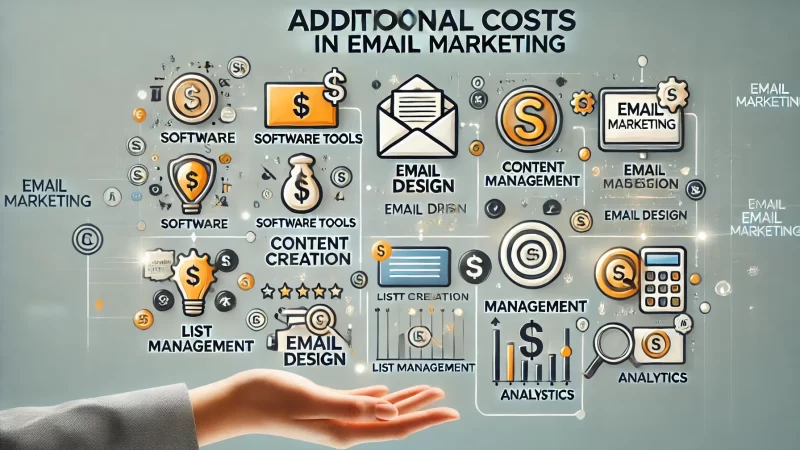
Beyond primary pricing models, email marketing involves supplementary expenses that impact overall budget. From list growth to compliance, understanding these costs ensures a more accurate and comprehensive budget for campaigns.
Email List Acquisition and Growth Expenses
Growing an email list may involve expenses for list acquisition or lead generation. Some businesses use paid ads or partnership campaigns to acquire new subscribers, and these methods can affect overall email marketing costs.
Organic list growth, through website signups or social media, often has a lower cost but may take more time. I recommend focusing on quality leads rather than volume, as an engaged list adds greater value over time.
Paid methods, like sponsoring content or leveraging influencers, can boost growth quickly but at a price. This approach suits businesses wanting faster list expansion, especially when launching new products or services.
Once subscribers join your list, nurturing and engaging them becomes key. An engaged list improves ROI, so budget for subscriber retention efforts, such as onboarding series or loyalty campaigns.
Compliance and Legal Considerations Costs
Maintaining compliance with email regulations, like GDPR and CAN-SPAM, incurs costs, particularly for businesses with international audiences. Fines for non-compliance can be steep, so investing in legal compliance ensures campaigns adhere to required standards.
Compliance often includes subscription management, consent tracking, and data security measures. I suggest regular audits to verify that your email practices meet regional and global standards, reducing potential risks.
For businesses handling personal data, investing in secure systems and processes is essential. This can involve integrating GDPR-compliant software or consulting with legal experts to ensure adherence to privacy laws.
Implementing compliance protocols provides peace of mind. Your audience values privacy, and by respecting their data, you build trust that enhances engagement and fosters long-term loyalty.
Training and Skill Development Investments
Training team members in email marketing strategies and tools may require an upfront investment. Ongoing skill development ensures your team stays updated on trends, enabling more effective and efficient campaign execution.
Some businesses prefer in-house training, where team members learn advanced tools and techniques. I suggest considering both in-house and external training options to provide well-rounded knowledge to your team.
Frequent updates to email platforms necessitate regular training sessions, especially for teams using complex automation tools. This keeps your campaigns relevant and ensures you’re maximizing each platform’s potential.
Budgeting for training helps equip your team with current best practices, from design to analytics. Well-trained staff can make a significant difference in campaign performance, often leading to higher ROI.
Integration with Other Marketing Tools Costs
Integrating email marketing with other tools, like CRM or social media platforms, provides a cohesive marketing approach. Many platforms charge for integrations, adding to the overall budget but offering substantial operational benefits.
This integration improves customer experience by ensuring consistent messaging across channels. I recommend integrating email with your CRM for personalized, data-driven campaigns that align with your broader marketing strategy.
Many email platforms offer API access for custom integrations, though these may come with setup fees or ongoing costs. Advanced integrations create smoother workflows, saving time and enhancing productivity.
Integrating tools streamlines data analysis, giving you a unified view of campaign impact. By combining insights across platforms, you can make more informed decisions that improve overall marketing effectiveness.
Strategies to Optimize Email Marketing Budget
Optimizing your email marketing budget is essential for cost efficiency. By leveraging affordable tools, focusing on quality content, and using automation, you can enhance your campaign’s effectiveness without overspending. Let’s explore these strategic methods.
Leveraging Free or Low-Cost Email Marketing Tools
Free or low-cost tools provide essential features for email campaigns, allowing small businesses to manage campaigns effectively. Many platforms offer no-cost plans with enough functionality for basic campaigns, making them ideal for startups or small lists.
Affordable tools, like Mailchimp and MailerLite, provide user-friendly interfaces with solid analytics. I suggest exploring these options if you’re on a tight budget, as they often meet essential needs without heavy investment.
Some paid tools also offer discounted starter packages for growing businesses. Choosing one that scales with your list size lets you start small while planning for future needs, which is a great cost-saving tactic.
Combining low-cost tools with strategic planning often yields high ROI. With basic yet effective capabilities, these platforms support growth without incurring overwhelming expenses, proving budget-friendly for many marketers.
Creating High-Quality Content In-House
Creating in-house content saves money and lets you tailor messages directly. It may require time, but the control over content quality and brand voice is invaluable. I recommend this approach if you want more personalized, brand-focused messaging.
Writing your own email content also enables you to quickly adapt campaigns based on audience feedback. Small adjustments in wording or design can improve engagement, which is easier to manage when done in-house.
High-quality content doesn’t always need extensive graphic design. Simple yet appealing emails often perform just as well. Focusing on clear, compelling messaging over flashy designs can keep your budget lean.
In-house content creation builds a closer connection with your subscribers. You’ll gain insights into what resonates best, which can lead to a more loyal audience and ultimately a better return on your email marketing investment.
Segmenting Email Lists for Targeted Campaigns
Segmenting email lists enables you to deliver content that feels relevant, leading to better open rates and engagement. Dividing your audience based on interests, behavior, or demographics makes each email more impactful and efficient.
Effective segmentation doesn’t have to be costly. Many email platforms offer basic segmentation features at no extra cost. I suggest starting with simple categories like new vs. returning customers to refine messages effectively.
Personalized emails built on segmentation tend to generate higher responses. Rather than sending one message to everyone, you’re reaching specific groups with tailored content, which improves results and saves on unnecessary outreach.
Segmentation is key for budget optimization, as it reduces email frequency to uninterested contacts. By focusing on responsive segments, you’ll spend your budget more wisely and increase your campaign’s ROI.
Utilizing Automation to Reduce Manual Efforts
Automation streamlines email processes, saving time and resources by handling repetitive tasks. Automating sequences like welcome emails or abandoned cart follow-ups ensures timely delivery without manual oversight, boosting both efficiency and engagement.
Many platforms offer automation in their basic plans, making it accessible for smaller budgets. I recommend using these features to handle routine messaging, as it saves effort and keeps engagement consistent.
Automated workflows allow you to focus on strategy and creativity rather than managing send times. A well-planned automation sequence works tirelessly in the background, maximizing impact while freeing up time.
With automation, you can target emails based on behavior, like recent purchases, without added cost. This enhances relevance, ensuring that your budget supports meaningful interactions rather than one-size-fits-all messages.
Regularly Analyzing Campaign Performance for Cost Efficiency
Regular analysis of email performance helps identify what’s working and where costs can be trimmed. Metrics like open rates and click-through rates provide insight into content effectiveness, allowing for data-driven adjustments.
Routine analysis often reveals trends, such as the best times to send emails or topics that resonate. I suggest monitoring these patterns to refine campaigns continually, ensuring your spending supports the highest-performing tactics.
Adjusting underperforming segments or messages based on data prevents unnecessary spending. This proactive approach ensures that each campaign iteration is an improvement, making budget use more efficient over time.
Tracking performance encourages smarter spending on high-impact areas. By regularly reviewing results, you can allocate funds more effectively, prioritizing strategies that generate the best ROI for your email campaigns.
Calculating Return on Investment for Email Marketing
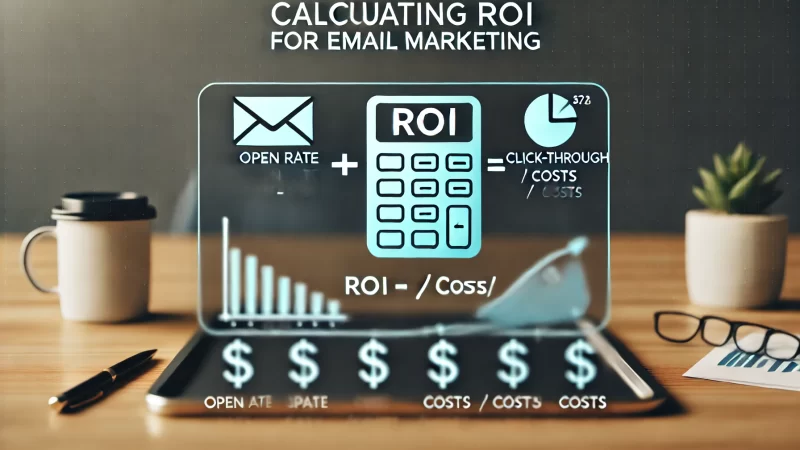
Calculating ROI for email marketing reveals the value of each campaign, enabling better financial planning. Tracking key metrics and customer behaviors allows you to assess if your email efforts are yielding positive returns, crucial for budget optimization.
Tracking Key Performance Indicators (KPIs)
KPIs like open rates, click-through rates, and conversions are core to assessing campaign success. These indicators show how well emails engage recipients, helping you adjust future strategies for maximum impact.
Regular KPI tracking highlights what resonates with your audience. I recommend focusing on metrics that align with your campaign goals, as these will provide the clearest insights into performance.
Conversion rates, in particular, reveal whether emails drive desired actions, like purchases or sign-ups. High conversions often indicate strong ROI, while low rates suggest areas for improvement.
Open rates also provide insight into subject line effectiveness. Testing variations can boost this KPI, making your emails more impactful while refining overall campaign costs.
Assessing Customer Acquisition Costs
Customer acquisition cost (CAC) in email marketing calculates how much you spend to gain each new subscriber or customer. Knowing CAC helps gauge if your campaigns are efficient and cost-effective for growth.
Tracking CAC enables you to compare costs with customer lifetime value, a key metric for long-term ROI. I suggest analyzing CAC periodically to ensure acquisition methods align with your budget and revenue goals.
A low CAC paired with a high conversion rate often signals successful campaigns. Adjusting targeting methods can further reduce CAC, making each campaign more efficient for future spending.
Reducing acquisition costs through segmentation or automation often yields better results. These strategies maximize the value of each campaign, reducing overall spending while improving ROI.
Evaluating Lifetime Value of Email Subscribers
Lifetime value (LTV) of subscribers shows their total worth to your business over time. High LTV indicates that your emails drive repeat engagement, making subscribers more valuable with each campaign.
Focusing on LTV helps shift the view from short-term gains to long-term relationships. I recommend nurturing subscribers through relevant, high-quality content to boost their LTV, which ultimately improves campaign profitability.
Regularly engaged subscribers with high LTV reduce the need for constant acquisition. This helps optimize budget allocation toward retention efforts, often more cost-effective than acquiring new customers.
Balancing acquisition with retention enhances ROI. Subscribers with high LTV provide continuous revenue, proving that consistent engagement boosts the return on your email marketing investment.
Analyzing Conversion Rates and Revenue Generated
Conversion rate analysis highlights the percentage of recipients who take action, such as purchasing or signing up. High conversions show that emails meet audience needs, improving revenue and proving campaign value.
Revenue tracking from conversions indicates if your campaigns generate a positive return. I recommend monitoring conversion-related revenue to understand which emails drive financial results, optimizing budget accordingly.
Comparing conversion rates across campaigns reveals trends, guiding future content decisions. This allows you to refine messaging and offers, creating a more effective email marketing strategy over time.
Focusing on conversions helps identify which tactics yield the most profit. By investing in high-conversion strategies, you maximize campaign ROI, ensuring email marketing remains a valuable channel for your business.
Case Studies: Email Marketing Costs Across Industries
Email marketing costs vary by industry, as each sector has unique requirements. Examining examples from e-commerce, SaaS, non-profits, and small businesses reveals diverse budget allocations, helping identify best practices for different business needs and campaign types.
E-commerce Email Marketing Budget Breakdown
E-commerce brands often allocate significant budgets to email marketing, given their focus on frequent promotions. Campaigns often require extensive product showcases and automation, as well as personalized offers to drive repeat purchases, impacting their overall budget needs.
Frequent campaigns mean e-commerce brands typically invest in reliable email platforms to handle volume. I suggest prioritizing tools with automation capabilities for abandoned cart recovery and seasonal promotions, as these drive conversions effectively.
E-commerce marketing also requires high-quality visuals and dynamic content to showcase products effectively. Brands often allocate funds to content creation for professional photography or engaging copy that appeals directly to their audience.
With seasonal sales like Black Friday, e-commerce brands may see temporary budget spikes. Planning for these periods ensures that the email strategy is fully funded during high-demand seasons, driving strong revenue returns.
SaaS Companies’ Email Marketing Expenditures
SaaS companies often focus on nurturing leads through educational content and trial offers. Email campaigns emphasize onboarding and customer retention, requiring an investment in automated, lifecycle email sequences that encourage user engagement and satisfaction.
Content for SaaS emails typically includes product guides, case studies, and updates. I recommend SaaS brands allocate budget for creating valuable, informative content that builds trust and showcases product benefits, which aids in long-term customer retention.
Personalization plays a key role, as SaaS brands tailor content based on user behavior. This requires segmenting audiences effectively to provide relevant emails that improve engagement, making segmentation and automation essential for SaaS success.
SaaS brands also benefit from data-driven insights. Analyzing metrics from email interactions, such as click-through rates on product updates, can optimize future campaigns, ensuring funds are directed toward high-impact areas.
Non-Profit Organizations’ Email Campaign Costs
Non-profits prioritize cost-effective campaigns focused on engagement and donations. Email marketing budgets often include funds for compelling storytelling, donor segmentation, and ongoing supporter engagement, allowing non-profits to connect emotionally with their audience.
Visuals that tell the story of the non-profit’s mission help increase engagement. I advise non-profits to invest in high-quality images and video content, as these elements resonate well and drive donor involvement.
Email segmentation is crucial for targeting different supporter groups, from recurring donors to new prospects. Many non-profits use segmented lists to deliver personalized appeals, increasing the likelihood of donation conversions.
Automation for non-profits is often used in welcome emails, donation confirmations, and periodic updates, keeping supporters informed and engaged without straining limited budgets. This enhances efficiency and ensures consistent communication.
Small Businesses’ Email Marketing Investment
Small businesses often work with limited budgets, making cost-effective tools and strategies essential. Many focus on newsletters and targeted promotions, opting for affordable or even free email platforms to keep costs manageable while driving engagement.
Small businesses benefit from simple, clear messaging that directly connects with local or niche audiences. I suggest using basic automation features for welcome emails and promotions to streamline communication without adding extra costs.
Content is often created in-house to reduce expenses. Small businesses can still achieve effective results by focusing on value-driven content and maintaining a consistent email schedule, building familiarity with subscribers over time.
For campaigns, small businesses may rely on seasonal promotions or partnerships to boost reach without large investments. These strategies maintain budget control while supporting steady subscriber growth and engagement.
Future Trends Impacting Email Marketing Costs
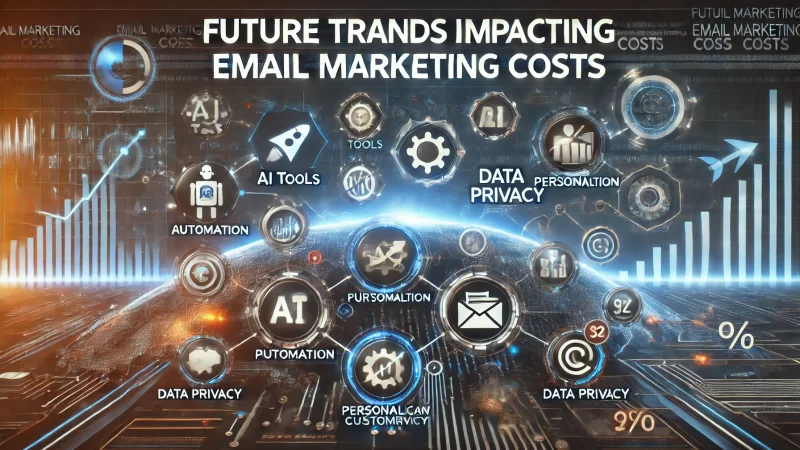
Emerging trends in email marketing technology are influencing costs, from artificial intelligence to personalization advancements. As these innovations evolve, they shape the budgets necessary to stay competitive in the email marketing landscape.
Artificial Intelligence and Machine Learning Integration
AI tools are transforming email marketing by enhancing personalization and automation. AI-driven insights help optimize send times and content, making campaigns more efficient. I believe investing in AI can streamline processes and improve overall campaign performance.
Machine learning algorithms provide insights into audience behavior, enabling predictive recommendations. These can optimize segmentation, ensuring that messages reach the right audience. AI-based solutions may come at a cost but often yield high ROI.
With AI, businesses can automate complex workflows without manual effort, reducing time spent on repetitive tasks. This automation improves productivity, allowing teams to focus on strategic elements like creative development and customer engagement.
AI-powered personalization, such as dynamic subject lines, elevates engagement levels. Investing in AI-based email platforms can yield significant results, especially for brands aiming to personalize each customer’s experience.
Advanced Personalization Techniques
Advanced personalization goes beyond names to adapt content based on behavior and preferences. Modern platforms enable detailed customization, delivering messages that feel individually tailored and resonate with each subscriber’s interests.
Dynamic content allows for real-time personalization, like showing products based on previous views. I suggest leveraging this capability if you want emails to feel more relevant, which can improve engagement rates and overall campaign performance.
Segmentation is evolving to include deeper factors, such as purchase history and browsing behavior. These insights allow for highly relevant messages, encouraging subscribers to take action and boosting return on investment.
Advanced personalization builds stronger connections with audiences. As subscribers receive more relevant content, they engage more actively, fostering long-term loyalty and higher value per subscriber, which is a worthwhile investment.
Interactive Email Content Development
Interactive content in emails—like polls, quizzes, or embedded videos—enhances engagement by inviting recipients to interact. These elements make emails more memorable and can improve click-through rates, though they may involve design and development costs.
Interactive elements allow for real-time feedback, making campaigns feel more dynamic. I recommend experimenting with interactive features for special campaigns to boost engagement and gather valuable insights on customer preferences.
Adding interactive content can set your brand apart. Simple animations or GIFs can add flair without a huge budget, creating a more engaging experience that keeps audiences interested and responsive to your emails.
Using interactive content strategically increases brand recall, as subscribers remember emails that stand out. This approach supports deeper engagement, which ultimately strengthens the effectiveness and return on your email marketing efforts.
Enhanced Data Privacy Regulations Compliance
Evolving data privacy laws, like GDPR and CCPA, impact email marketing practices. Compliance is essential to avoid penalties, but it often requires investments in secure data management systems and clear consent practices for subscribers.
Ensuring compliance involves setting up processes for handling personal data, which may incur added costs. I advise working with a privacy consultant if needed to align your campaigns with current regulations, protecting both your business and subscribers.
Building trust around data privacy can improve engagement, as subscribers feel safe sharing information. Transparent practices foster loyalty, enhancing long-term relationships and increasing open rates and overall campaign success.
Regular audits ensure that email practices remain compliant, even as laws change. These audits protect your brand reputation and demonstrate a commitment to respecting customer data, which is crucial for modern email marketing.
Making Informed Decisions on Email Marketing Investments
Informed decision-making in email marketing balances cost, quality, and strategic alignment with business goals. By evaluating your specific needs, you can maximize return on investment while maintaining effective and compliant campaigns.
Balancing Cost and Quality in Email Campaigns
Effective email marketing requires balancing expenses with quality to achieve desired outcomes. High-quality campaigns often drive better engagement, but budget constraints mean finding an approach that meets both financial and performance goals.
Investing in quality ensures emails that resonate, from visuals to copy. I suggest prioritizing elements that directly impact engagement, such as design and personalization, which can make each campaign feel relevant and valuable to readers.
Quality doesn’t always mean high costs. Affordable options, like in-house content creation, can keep costs manageable while maintaining a strong brand voice. This balance allows brands to connect meaningfully without overspending.
Strategic spending on impactful elements maximizes ROI. By focusing on quality where it matters most, you create an effective email strategy that works within budget limitations, delivering consistent and valuable outcomes.
Aligning Email Marketing Budget with Business Goals
Aligning your email budget with business goals ensures that each campaign supports broader objectives, from brand awareness to revenue growth. This alignment makes budgeting more strategic and intentional, increasing the likelihood of meeting your targets.
Setting clear goals, like acquisition or retention, helps prioritize spending. I recommend defining objectives at the start, as this guides budget allocation and ensures resources support impactful campaigns.
A goal-aligned budget clarifies which campaigns need higher investment, such as product launches. This approach optimizes funds by dedicating resources to campaigns that align closely with revenue or engagement targets.
Regularly reassessing goals ensures your email strategy remains relevant. As goals evolve, so should budget allocations, maintaining alignment and ensuring email marketing contributes to the overall business vision effectively.
Continuously Monitoring and Adjusting Email Marketing Spend
Continuous monitoring allows for responsive budgeting, adapting spending to align with performance. Reviewing campaign results provides insights that guide adjustments, ensuring funds are used where they drive the best outcomes.
Regular adjustments prevent wasted resources. If certain tactics underperform, reallocating funds to successful strategies ensures budget efficiency, making every dollar count toward reaching your email marketing goals.
Monitoring also reveals opportunities for optimization, like segmenting audiences further. I advise using these insights to refine strategies continually, which helps maintain a high return on investment as market conditions shift.
Adjusting based on results keeps campaigns fresh and relevant. This proactive approach enables brands to optimize budgets effectively, driving ongoing improvements that enhance both engagement and cost efficiency.
Leveraging Insights to Maximize Email Marketing ROI
Leveraging insights from data analysis maximizes email marketing ROI by highlighting what works best. Metrics like open and conversion rates reveal which elements drive success, enabling data-driven decisions for future campaigns.
Learning from past campaigns allows brands to replicate successful tactics. I suggest using insights to create a template for future efforts, focusing on proven strategies that consistently deliver results.
Experimenting with different approaches builds a deeper understanding of audience preferences. As you gather data on what resonates, you can tailor campaigns to boost engagement and ROI, refining your approach over time.
Insight-driven strategies ensure funds support high-impact areas. By focusing on tactics backed by data, you enhance campaign relevance and effectiveness, maximizing both your investment and the return on each email sent.


